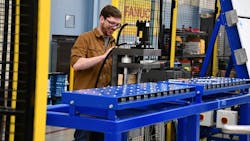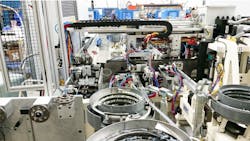How to Use Automation to Recession-Proof Your Business
In uncertain economic times, businesses face numerous challenges that can hinder their efficiency, safety, and sustainability. One key strategy companies can deploy to withstand recessionary periods is to consider the impact automation can have on their business. This article explores how companies ensure safe, consistent operations, and position themselves for sustainable growth once the economic storm passes.
What Does It Mean to Recession-Proof a Business?
Recession-proofing involves positioning your company to remain resilient and stable even when market conditions are unfavorable. Typically, this includes some combination of improving cash flow, optimizing resources, and trimming unnecessary expenses. But recession-proofing can, and should, go beyond managing mere financials; it also means ensuring your company is adaptable and flexible, uses data-driven decision-making, and is prepared to compete in an environment of reduced demand and fierce competition. Investing in automation is one way businesses can streamline their processes, reduce labor dependency, and boost productivity—all critical factors in weathering an economic downturn.
Mitigating the Domino Costs of Labor Turnover
Recession-proofing a business should include taking action to address the manufacturing industry's biggest pain points in your company before an economic downturn. In an industry where labor shortages can severely disrupt production, manufacturers are increasingly turning to automation as a strategic solution.
On average, there are between 500,000 and 700,000 job openings in the U.S. manufacturing sector at any given time, with many positions going unfilled due to the undesirability of repetitive, low-skill jobs. Automation can fill this gap by taking over monotonous tasks, allowing companies to redirect their human resources to higher-level, skilled roles. This not only improves efficiency but also opens up new opportunities for employees who can now focus on more complex tasks, such as machine operation and maintenance.
Automated systems can operate 24/7 without the need for breaks or holidays, significantly maximizing uptime while providing labor consistency. It's also important to remember that labor costs extend far beyond mere wages. The cost of benefits like health care and disability insurance continues to rise, driving labor costs up. Plus, recruiting and training new or replacement workers requires more onboarding effort and resources than businesses can extend.
Unfortunately, higher turnover combined with too few resources often results in inadequately trained employees and lower-quality products over time. Inconsistency in product quality will negatively impact brand reputation and consumer loyalty, reducing market share and impacting your bottom line. Plus, inconsistency in employee training protocols because of a lack of resources can seriously impact safety, leading to preventable accidents. Automation offers companies consistent, reliable output that can improve facility safety and mitigate high turnover rates and the associated costs of recruitment, training, and beyond.
For businesses that produce essential consumer goods, ensuring that products can get to market quickly and reliably is critical. Labor shortages can disrupt this flow, leading to a loss of market share. Plus, in a recessionary environment, competition will inevitably increase as demand decreases. Ensuring your company has solidified consumer loyalty within its market segment should be a key focus area. By investing in automation, companies can safeguard their production capacity, ensuring they can meet market demand regardless of labor constraints. Beyond filling the labor gap, automation ensures consistency in output, enhances product quality, and helps safeguard against the rising costs associated with employee turnover.
Accuracy, Scalability, and Standardization: The Benefits of Holistic Automation
Automation offers substantial benefits including higher production output, enhanced precision and consistency, and increased employee safety. While it's easy to make the case for the financial benefits of automation, improved workplace safety and product quality should not be overlooked as these factors have wide-reaching implications across organizations.
"There is nothing more important than safety to any organization, any factory," says Carl Doeksen, Global Robotics Automation Director at 3M. "We find that the safest factories are also the most efficient and are putting out the highest quality products. Quality lies in precision and repeatability."
The key to sustainable and consistent cost-minimization lies in safety and quality assurance. One of the main facets of quality, as Doeksen says, is precision and repeatability. This is where having adaptable manufacturing lines offers a huge advantage. Automation systems can be designed for reuse across different production lines, making them a flexible and cost-effective solution for driving consistency across products. Plus, by standardizing mechanical, electrical, and software components of machines, businesses can simplify maintenance and lower the total cost of ownership over time. The key to efficiency is streamlining operations—making the equipment you use as widely applicable as possible.
As such, deployable modules can be powerful tools for recession-proofing. These adaptable, standardized systems can be rapidly implemented to enhance operations across various sectors. In warehousing, for instance, deployable modules might include automated order fulfillment systems that integrate robotics and software to streamline processes. Their key advantages lie in their ability to be quickly adapted to existing infrastructures, minimizing the time and cost of overhauls. The scalability of deployable modules allows businesses to flexibly adjust to market demands without requiring large capital investments, making them both cost-effective and efficient.
For example, incorporating robotics into business operations can maintain an extremely high accuracy level on the first pass, significantly reducing errors and waste. Robots, particularly in warehouse settings, perform tasks such as picking, packing, and transporting goods. These automated systems increase productivity by operating continuously, reducing cycle times, and optimizing labor utilization. This high level of precision is especially valuable for tasks requiring exact measurements, such as working within 10-millimeter tolerances—something challenging for humans but routine for robots.
Automation not only drives financial gains through higher production output and reduced operational costs but also plays a pivotal role in ensuring safety and efficiency within the workplace. By minimizing human involvement in repetitive and hazardous tasks, automation reduces the risk of workplace injuries while enhancing overall productivity. As Doeksen emphasizes, the safest factories are often the most efficient, consistently producing the highest quality products. The precision and repeatability offered by automated systems not only improve product quality but also contribute to long-term cost savings through reduced errors and waste. For businesses aiming to remain competitive in an ever-changing market, investing in automation—whether through deployable modules or robotics—offers a flexible, scalable solution that promotes both operational excellence and a safer, more efficient work environment.
Making Automation Work for You
There's no automated process for adopting automation. Investing in automation should involve a highly tailored approach for your company's specific pain points and needs. According to McKinsey, "[a] significant portion of automation projects fail, largely for three reasons: lack of cohesive vision, a poor understanding of automation technology by leadership, and misalignment of beliefs and principles within the organization.”
Companies that have already embraced automation over the long term often develop corporate automation teams focused on standardizing their operations. These teams work with partners like Wauseon to design and implement automation solutions that can be reused across multiple facilities. For businesses just starting their automation journey, partnering with an automation systems integrator is crucial in determining which processes to automate, how to properly operate and maintain the equipment, and how to achieve the best ROI.
By partnering with an automation systems integrator, businesses can benefit from a holistic, long-term approach to automation that enables them to scale efficiently and effectively. Look for an automation systems integrator who will conduct on-site consultations where their experts identify the best systems to automate, calculate return on investment (ROI), and outline opportunities for cost savings.
Wauseon Machine helps businesses focus on the full lifecycle management of their automation systems, not only saving them money but also positioning them for sustainable growth. Because automation offers consistency in producing high-quality products, companies all over the world in just about every industry are adopting automation to become stronger global competitors. It could turn out that automating not only makes your company recession-proof but also is a means to survival in today's global economy.
About the Author
Scott Anair
President and CEO, Wauseon Machine
Scott Anair is an accomplished business leader with experience in operations, engineering, program management, and business development.
Currently the president and CEO of Wauseon Machine, Anair graduated from the University of Michigan with a bachelor's degree in Industrial and Operations Engineering. Previously, Anair has been the president of JR Automation's Systems Division as well as worked in various leadership capacities at Sandvik and Johnson Controls, totaling over 30 years.


